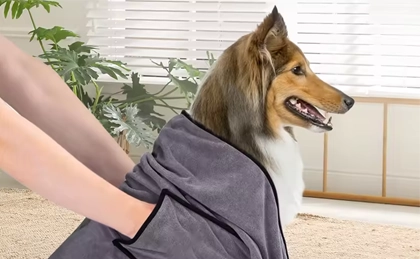Shelties are sensitive and eager working dogs, making it easy for beginners to start clicker training. All you need is a little know-how, a clicker, and some small dog treats to get started.

Clicker training is ideal for Shelties who are sensitive and eager to please.
Clicker training uses psychological conditioning to associate commands, behaviors, and rewards. The addition of clicks hard-wires your Sheltie to respond to commands, ultimately without the need to give dog treats.
How Clicker Training Works
Clicker training is much like traditional dog training, in that it uses a two-step process of learning and reinforcement.
This process has been scientifically demonstrated in dogs (and humans) since the time of Pavlov's Dogs. It's a powerful way of programming automatic behaviors and is frequently used in traditional dog training. So how is this different?
Clicker training adds one small step to the process: psychologically associating clicks with rewards. The sound of the clicker becomes just as powerful as a dog treat, so you don't have to overfeed your dog every time you want to reinforce a behavior.
With clicker training, your Sheltie becomes click-motivated instead of treat-motivated.
Now, there's no special significance to the sound of the clicker. Not at first. It's just a very specific sound for your dog to recognize, what's known as the neutral stimulus, that he won't otherwise hear outside of dog training.
With a few repetitions, the clicker comes to represent something meaningful to your dog. It becomes associated with praise and treats to become a conditioned stimulus. This is where the magic happens.
3 Things You Need to Start Clicker Training
1. A Clicker
Choose a clicker that gives a loud and consistent click sound. I recommend the HoAoOo Pet Training Clicker.

2. Dog Training Treats
Get a stash of quick-to-eat dog treats for the initial period of association between treats and clicks. Pet Botanics Training Reward are a winner.

3. A Clicker Training Book
You can start clicker training with the principles laid out here today. If you want more detailed advice and routines, see Reaching the Animal Mind: Clicker Training and What It Teaches Us About All Animals by Karen Pryor, the inventor of clicker training. She explains the science, how and why it works, and offers step-by-step instructions on how to clicker train any animal in your life.

Example 1: How to Teach The "Sit" Command
Here's a three-step method to teach one of the most basic dog commands: sit. You can teach this to most puppies from four months old in a single 5-minute session.
Your Sheltie doesn't understand many words (yet!) so begin by physically demonstrating what the word "Sit" means.
Step 1. Say "Sit" and gently push his butt to the ground. As soon as he's sitting, click and feed him a treat.
Repeat this a few times. Each time he should sit more readily.
Now he knows what sit means, and that sitting leads to a treat. At the same time, you're building an association between clicks and treats.
Step 2. Say "Sit" and wait for him to sit all by himself. As soon as he's sitting, click and feed him a treat.
If he doesn't sit on his own, repeat the demonstration phase a few more times. But you'll probably be surprised how quickly he picks this up.
Finally, once he understands the command, you can test if he understands the association. Now you don't need to give him a treat anymore. Just give him the click, and he'll still respond to your command.
Step 3. Say "Sit" and wait for him to sit all by himself. As soon as he's sitting, click but don't feed any treat.
Once he sits several times in a row without any treat rewards, you know you've instilled the command, the behavior, and the positive association with clicks. Success!
Now you can use clicking training to teach your Sheltie other routines, and with a decreasing reliance on treats. In time, eliminate treats altogether. You can entrain all kinds of obedience and tricks without overfeeding your Sheltie and running through copious treats.
The ultimate goal of clicker training is to drop the clicker too, so that your Sheltie responds to your commands out of a hard-wired association. As a dog owner that's a joy to behold.
Example 2: How to Teach The "Shhh" Command
What about more difficult commands, like preventing a behavior? Shelties are known for their full-bodied barking which can drive you crazy if left unchecked. So let's look at how to stop your Sheltie barking using clicker training.
Barking is a strong impulse in Shelties, so this won't be as easy as the "Sit" command. But it does work. Only attempt this once you've nailed half a dozen other commands and you have a good clicker training rapport with your dog.
First, encourage your Sheltie to bark. This may sound counter-intuitive, but it's proven very effective if your Sheltie has already found her voice. The aim to to teach her two commands in opposition: "Speak" and "Shhh".
Step 1. Say "Speak" and perform a little hype for your Sheltie to bark in excitement. When she barks, click once and feed a treat.
While she's eating her treat, she's not barking. Perfect. Now immediately condition her to be silent.
Step 2. Say "Shhh" and hold up your hand to get her attention. As long as she's not barking, click once and feed a treat.
That's it! Reinforce this routine half a dozen times then give her some time to process it. Do it every day for a week, in short training bursts.
The trick is to be prompt with your clicks. And of course, if your Sheltie barks without the "Speak" command, don't offer a click or reward.
Once she responds consistently to the "Shhh" command, drop the treats and just use clicks to reinforce this learned behavior.

There's a good boy!
The Benefits of Clicker Training
Why is clicker training preferable to other methods of dog training?
It's Positive. - Clicker training only ever reinforces correct behaviors instead of punishing incorrect ones, so your Sheltie truly enjoys your training sessions.
It's Healthy. Clicker training reduces and then eliminates the need to repeatedly offer dogs treats, which can lead to excess weight gain in Shelties.
It's Fun. Once your dog becomes clicker-wise, she'll understand the rules of the game and thoroughly enjoy her role as she receives your positive click-feedback.
It's Fast. Becoming clicker-wise also produces generalization, where clicking automatically puts her in a state of obedience and focus.
Clicker Training vs Aversive Dog Training
If your Sheltie doesn't follow a command during training, you simply don't click. You're never required to punish nor dominate your sensitive Sheltie. He's highly motivated to get that click, so if he doesn't obey a command then he likely doesn't understand the word yet, didn't hear you, or is too distracted to focus.
Some dog training methods use aversive techniques like leash jerks and verbal punishment. Their goal is to train dogs to respond to commands out of respect. Unfortunately, this is synonymous with dominating dogs into submission. This can be disastrous for nervous Shelties, who respond to aggressive trainers with panic and become emotionally dysregulated.
All dog training methods are ultimately built on the same principle: animals seek pleasure and avoid pain. While clicker training exploits the pleasure-seeking drive, aversive training exploits the pain-avoidance drive. Both are powerful motivators of behavior, but there's simply no need to resort to dominating dogs if they can respond to positive dog training methods like clicker training.

How to Groom a Sheltie

The Best Brushes for Shelties

10 Things to Know About Shelties

101 Sheltie Names

101 Shelties in The Bath

How to Bath Your Sheltie

30 Foods Toxic to Dogs

Coping with The Loss of a Sheltie

